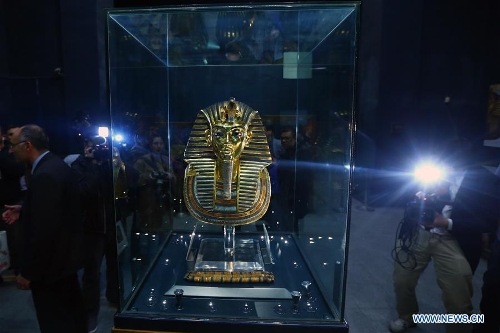
Photo taken on Dec. 16, 2015 shows the golden mask of Tutankhamun at the Egyptian Museum, in Cairo, Egypt. The golden burial mask of King Tutankhamen, one of ancient Egypt's most famous artifacts, was put back Wednesday on display at the Egyptian Museum after eight weeks of restoration by an Egyptian-German team. (Xinhua/Ahmed Gomaa)
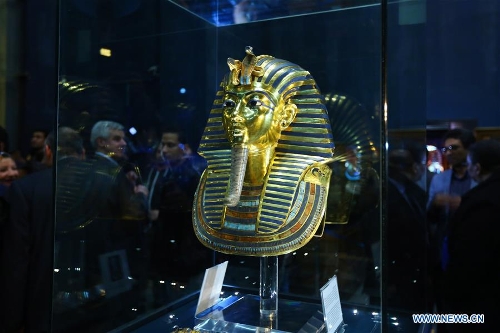
Photo taken on Dec. 16, 2015 shows the golden mask of Tutankhamun at the Egyptian Museum, in Cairo, Egypt. The golden burial mask of King Tutankhamen, one of ancient Egypt's most famous artifacts, was put back Wednesday on display at the Egyptian Museum after eight weeks of restoration by an Egyptian-German team. (Xinhua/Ahmed Gomaa)
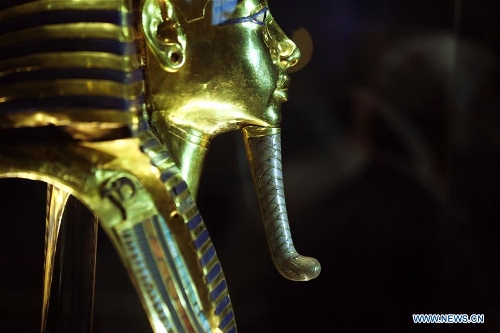
Photo taken on Dec. 16, 2015 shows details of the golden mask of Tutankhamun at the Egyptian Museum, in Cairo, Egypt. The golden burial mask of King Tutankhamen, one of ancient Egypt's most famous artifacts, was put back Wednesday on display at the Egyptian Museum after eight weeks of restoration by an Egyptian-German team. (Xinhua/Ahmed Gomaa)
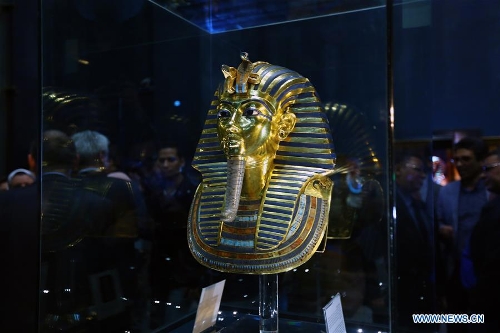
Photo taken on Dec. 16, 2015 shows the golden mask of Tutankhamun at the Egyptian Museum, in Cairo, Egypt. The golden burial mask of King Tutankhamen, one of ancient Egypt's most famous artifacts, was put back Wednesday on display at the Egyptian Museum after eight weeks of restoration by an Egyptian-German team. (Xinhua/Ahmed Gomaa)

Media representatives take photos and videos of the golden mask of Tutankhamun, at the Egyptian Museum, in Cairo, Egypt, on Dec. 16, 2015. The golden burial mask of King Tutankhamen, one of ancient Egypt's most famous artifacts, was put back Wednesday on display at the Egyptian Museum after eight weeks of restoration by an Egyptian-German team. (Xinhua/Ahmed Gomaa)
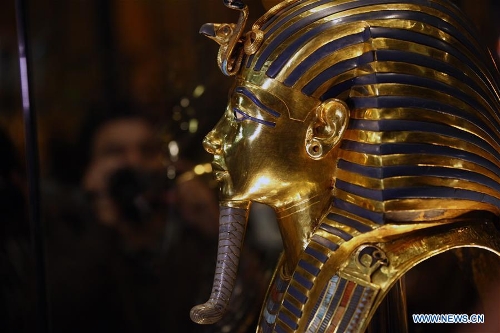
Photo taken on Dec. 16, 2015 shows details of the golden mask of Tutankhamun at the Egyptian Museum, in Cairo, Egypt. The golden burial mask of King Tutankhamen, one of ancient Egypt's most famous artifacts, was put back Wednesday on display at the Egyptian Museum after eight weeks of restoration by an Egyptian-German team. (Xinhua/Ahmed Gomaa)
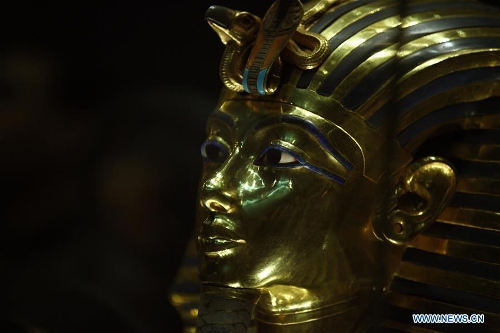
Photo taken on Dec. 16, 2015 shows details of the golden mask of Tutankhamun at the Egyptian Museum, in Cairo, Egypt. The golden burial mask of King Tutankhamen, one of ancient Egypt's most famous artifacts, was put back Wednesday on display at the Egyptian Museum after eight weeks of restoration by an Egyptian-German team. (Xinhua/Ahmed Gomaa)
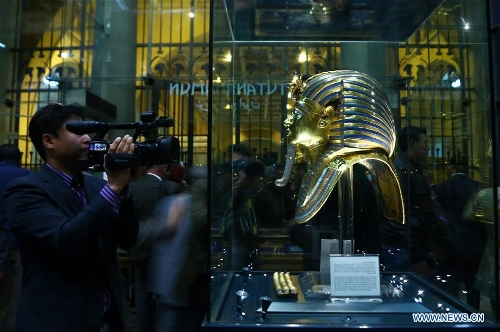
Media representatives take photos and videos of the golden mask of Tutankhamun, at the Egyptian Museum, in Cairo, Egypt, on Dec. 16, 2015. The golden burial mask of King Tutankhamen, one of ancient Egypt's most famous artifacts, was put back Wednesday on display at the Egyptian Museum after eight weeks of restoration by an Egyptian-German team. (Xinhua/Ahmed Gomaa)

Photo taken on Dec. 16, 2015 shows the golden mask of Tutankhamun at the Egyptian Museum, in Cairo, Egypt. The golden burial mask of King Tutankhamen, one of ancient Egypt's most famous artifacts, was put back Wednesday on display at the Egyptian Museum after eight weeks of restoration by an Egyptian-German team. (Xinhua/Ahmed Gomaa)

Photo taken on Dec. 16, 2015 shows the golden mask of Tutankhamun at the Egyptian Museum, in Cairo, Egypt. The golden burial mask of King Tutankhamen, one of ancient Egypt's most famous artifacts, was put back Wednesday on display at the Egyptian Museum after eight weeks of restoration by an Egyptian-German team. (Xinhua/Ahmed Gomaa)
‹ ›
The golden burial mask of King Tutankhamen, one of ancient Egypt's most famous artifacts, was put back Wednesday on display at the Egyptian Museum on after eight weeks of restoration by an Egyptian-German team.
"Thanks God, it is done," German conservator Christian Eckmann, who oversaw the restoration works, told reporters during a press conference at the Egyptian Museum.
In January, media reported that the long shinny blue beard of the king was damaged by the museum's cleaning workers and then was glued back onsite hastily and unprofessionally in August 2014.
According to the reports, dried glue was visible along the joints between the beard and the mask.
This led the Egyptian government to seek the help of professional conservators from Germany to restore the priceless relic.
The German ministry of foreign affairs donated 50,000 Euros for the restoration process of the mask which started on October 10.
Speaking to reporters, Eckman said the team discovered during the restoration works an internal gold tube which is still stuck in the beard. The tube was used to connect the beard to the mask.
"This was one of the most challenging procedures to separate this internal tube in order to clean the beard," he added.
"We have the pleasure to do present the mask in its original glance again," Eckman told reporters.
For his part, Egyptian minister of antiquities Mamdouh Damati told reporters that the epoxy was successfully removed without using any chemical solvents.
The mask has gone through an unprecedented comprehensive scientific analysis and laser scanning, adding that the beard was detached from the mask with a very simple mechanical way, the minister said.
Tutankhamun, who ascended to the throne at the age of nine and died at the age of 19, is the world's best known pharaoh of ancient Egypt.
The young king ruled from 1332 BC to 1323 BC, during a period known as the New Kingdom in Egypt's history.
He won his fame for his tomb, which was discovered by British Egyptologist Howard Carter in 1922 and has remained one of the best preserved.









